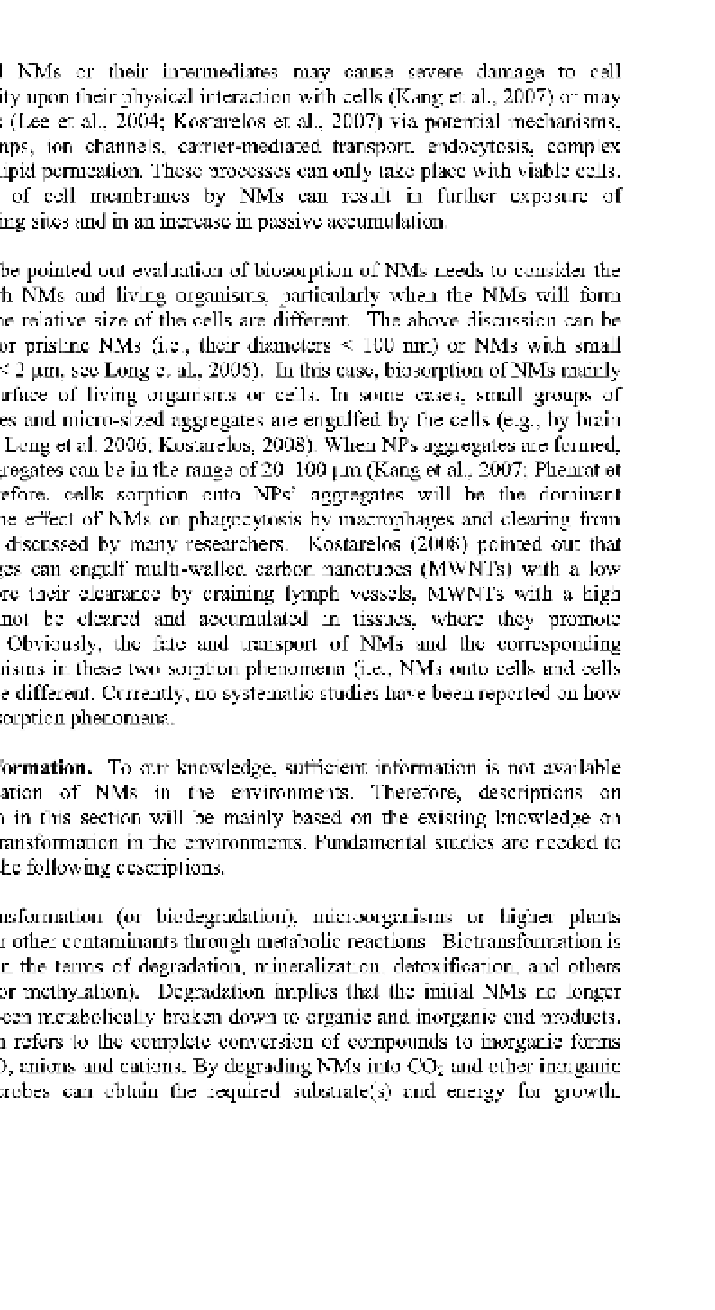Environmental Engineering Reference
In-Depth Information
Biosorbed NMs or their intermediates may cause severe damage to cell
membrane integrity upon their physical interaction with cells (Kang et al., 2007) or may
cross membranes (Lee et al., 2004; Kostarelos et al., 2007) via potential mechanisms,
such as ion pumps, ion channels, carrier-mediated transport, endocytosis, complex
permeation, and lipid permeation. These processes can only take place with viable cells.
Permeabilization of cell membranes by NMs can result in further exposure of
intracellular binding sites and in an increase in passive accumulation.
It should be pointed out evaluation of biosorption of NMs needs to consider the
properties of both NMs and living organisms, particularly when the NMs will form
aggregates and the relative size of the cells are different. The above discussion can be
viewed mainly for pristine NMs (i.e., their diameters < 100 nm) or NMs with small
aggregates (e.g., < 2 |im, see Long et al., 2006). In this case, biosorption of NMs mainly
occurs on the surface of living organisms or cells. In some cases, small groups of
nanosized particles and micro-sized aggregates are engulfed by the cells (e.g., by brain
microglia (BV2), Long et al. 2006; Kostarelos, 2008). When NPs aggregates are formed,
most of these aggregates can be in the range of 20-100 |im (Kang et al., 2007; Phenrat et
al., 2007). Therefore, cells sorption onto NPs' aggregates will be the dominant
phenomenon. The effect of NMs on phagocytosis by macrophages and clearing from
tissues has been discussed by many researchers. Kostarelos (2008) pointed out that
while macrophages can engulf multi-walled carbon nanotubes (MWNTs) with a low
aspect ratio before their clearance by draining lymph vessels, MWNTs with a high
aspect ratio cannot be cleared and accumulated in tissues, where they promote
carcinogenesis. Obviously, the fate and transport of NMs and the corresponding
cytotoxic mechanisms in these two sorption phenomena (i.e., NMs onto cells and cells
onto NMs) will be different. Currently, no systematic studies have been reported on how
to study the two sorption phenomena.
Biotransformation.
To our knowledge, sufficient information is not available
on biotransformation of NMs in the environments. Therefore, descriptions on
biotransformation in this section will be mainly based on the existing knowledge on
contaminant biotransformation in the environments. Fundamental studies are needed to
confirm/explore the following descriptions.
In biotransformation (or biodegradation), microorganisms or higher plants
transform NMs or other contaminants through metabolic reactions. Biotransformation is
often described in the terms of degradation, mineralization, detoxification, and others
(e.g., activation or methylation). Degradation implies that the initial NMs no longer
exists and have been metabolically broken down to organic and inorganic end products.
Biomineralization refers to the complete conversion of compounds to inorganic forms
such as CC>2, H2O, anions and cations. By degrading NMs into CC>2 and other inorganic
components, microbes can obtain the required substrate(s) and energy for growth.

Search WWH ::

Custom Search